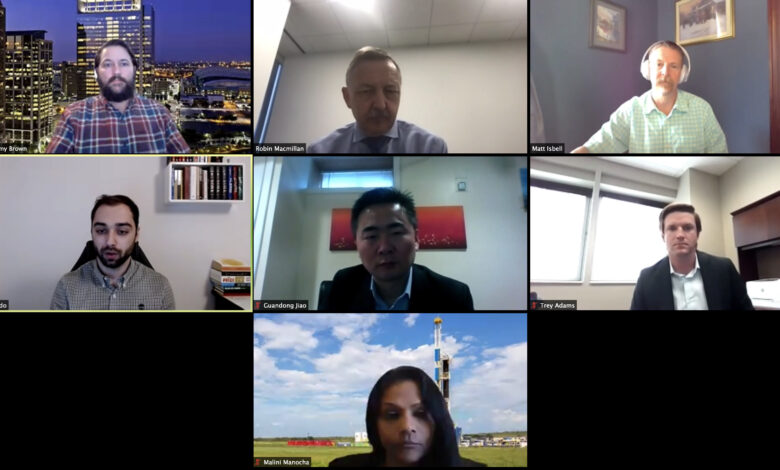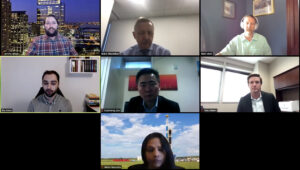Remote operating centers leverage smart tools, automation to boost efficiency, facilitate collaboration

Industry continues efforts to advance remote technologies to improve drilling, geosteering and wireline operations, unlock greater efficiencies from the rig site
By Stephen Whitfield, Associate Editor
As the oil and gas industry navigates difficult economic terrain and seeks systems for improving efficiencies, remote systems and real-time operating centers (RTOCs) may be at the center of a paradigm shift. However, in order to realize greater operational efficiencies, operators and drilling contractors will likely have to invest in tools that can enable greater collaboration.
At Helmerich and Payne (H&P), remote operations have been an area of focus for years, and Trey Adams, Vice President of H&P, said they are critical for drilling contractors seeking to drill consistent, high- quality and lower-cost wells.

“As we’ve honed in on remote operations, we’ve focused on three core areas. Are we improving well quality and placement through what we’re doing, are we lowering costs and are we reducing risk?” Mr Adams said. “You have to think about these as the three core tenets of creating shareholder value. Our remote operations have to do these things to be successful. We have to be agile and adaptive, and work with our operators to create value.”
Mr Adams was one of five industry experts to address how remote operations centers can fit into the drilling landscape during a panel discussion at the IADC Drilling Engineers Committee’s Q4 2020 Technology Forum. He spoke about the company’s three remote operating centers – in Tulsa, Okla.; Dallas, Texas; and Denver, Colo. – where personnel oversee automated directional drilling and sliding operations happening in real time. The centers have not only helped the company reduce on-site personnel but have also played a significant role in improving efficiency. In fact, the average number of wells drilled per H&P rig per year has increased from 14 in 2014 to 18 in 2018, he noted.
For Hess, a significant milestone in the development of the company’s remote operating capabilities came with the 2016 launch of a real-time center for directional drilling operations and geosteering. Leveraging the new facility, Hess partnered with Nabors to implement an automated directional software guidance system that covered up to six rigs in the Bakken at one point in 2019.
Jeremy Brown, Supervisor of the real-time center, noted the impact the center has had on Hess’ safety, quality, delivery and cost measures. Since 2015, the company has seen a 30% reduction in drilling cost, driven largely by a 26% reduction in well cycle times over the same period. Instead of requiring 12 directional drillers onsite for one well, Hess now utilizes a single directional driller for every three wells; additional directional drillers are stationed at the real-time center.
Despite financial limitations resulting from the recent downturn, Mr Brown said Hess plans to take “small steps” to add value to the center in the near future. It will focus on further developing automated rig controls and coming up with a “Digital Well Plan to Wellsite Action” roadmap to prepare the center for an increase in drilling activity.
Down the road, Hess also hopes to develop a digital well construction system that incorporates automated processes into everyday activity.
“We want to digitalize everything we do from start to finish, from the time we start planning the well, to when the rig moves in, gets up and starts drilling. If we can get that all into a step-by-step process where we can run the systems that control everything, that’s going to help us in terms of repeatability from well to well,” Mr Brown said.
Malini Manocha, Senior Manager – Operations Excellence at Nabors, said an effective remote operations center focuses on the right set of people, tools and process combinations. Moreover, it should allow drillers to be involved in every step of the drilling process, from planning to execution.
Nabors’ primary focus with its remote operating centers, she said, is to invest in collaborative and decision-making tools that can be incorporated across the organization. Some of these tools include proprietary systems, including an interactive rig activity planning, scheduling and coordination system that provides guidance to local and remote personnel on past, ongoing and future rig operations. The center also leverages an advanced directional steering control system, and other virtual teaming tools that allow personnel at the remote center to actively participate in the drilling process on various rigs.
“What we’re looking at with Nabors is a more agile, collaborative system between us and the operators, where we use planning tools to more effectively work on a default process for running the rig,” Ms Manocha said. “We want to deliver performance on scale for digital workflows, be more solution- and design-focused, and give ourselves more power in a decision-making role.”
In addition to drilling, remote operating systems can be extremely useful in enabling more efficient wireline performance, as Schlumberger has seen with its Performance Live software suite. Launched last June, the suite provides users with access to data and a platform to collaborate with offsite domain experts, who carry out analytical activities like formation evaluation, wellbore positioning, directional drilling, well intervention, data quality and evaluating overall operational readiness.
Guandong Jiao, Remote Operations Manager, Wireline at Schlumberger, said Performance Live is not exclusively a wireline tool – the system was used in more than 60% of Schlumberger’s drilling jobs, covering more than 18,000 runs, in 2019. However, it is a key factor to the significant increase in remote wireline runs the company has overseen in recent years. Schlumberger went from 150 remote wireline runs in 2016 to more than 12,000 in 2019, and as of last October, approximately 30% of its wireline runs were being done remotely.
Mr Jiao said the system automates a number of common processes covering traditional wellsite roles, eliminating many physical tasks and allowing engineers to focus on improving wireline performance.
“In the traditional wireline model, we have one crew led by a field engineer at the wellsite,” he explained. “With the remote operation model, that field engineer moves to a remote operating center, and he now becomes a remote operations engineer. He can conduct additional activity from the center. At the wellsite, the crew, under a new supervisor, can focus on the physical tasks – managing wellsite safety, interfacing with the customer – while relaying that information back to the center.”
Remote capabilities can also play significant roles in other aspects of the drilling rig. At Drillmec, its remote assistance center provides three primary functions: personnel training, where its personnel at the fabrication yard can train remotely located rig personnel using a combination of smart glasses and drone technology; factory allowance testing, which can be observed by rig owners from any location; and rig site assistance, where Drillmec’s customer support team can perform remote diagnostics and guide maintenance without having to travel.
Elia Abdo, R&D Engineer and Technical Trainer at Drillmec, said the company also uses a data management system in which its support teams and rig owners can share data from the rig, as well as schematics, documents and videos in real time. He called the system “the central part of what we do,” because it enables easy connectivity between personnel in different locations.
“The strong point of the system is how we are able to connect so many devices together,” he said. “You can connect an off-the-shelf tablet to this system and use it for communication via video or voice chat, you can share documents, manuals, graphs, procedures. You can connect glasses with the same type of functionality as the tablet and see everything you need to see.” DC




